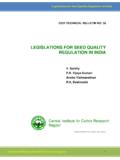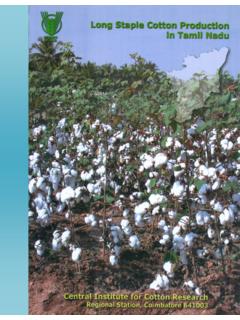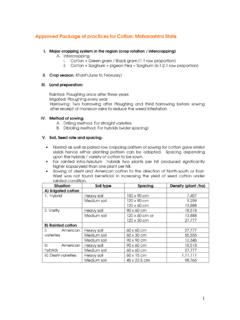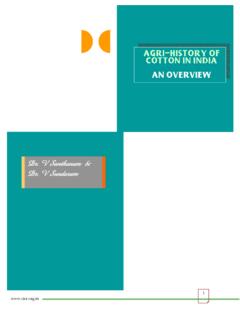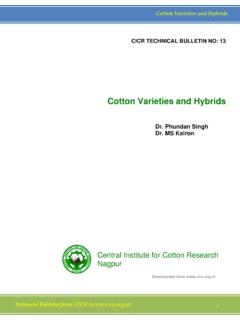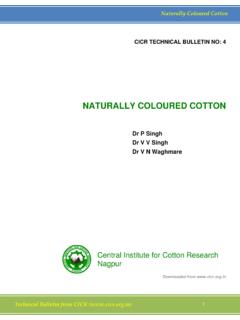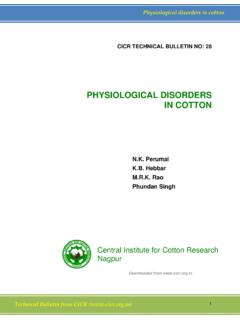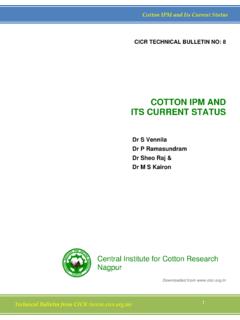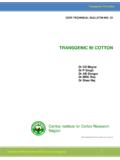Transcription of COTTONSEED OIL QUALITY, UTILIZATION AND …
1 Technical Bulletin from CICR ( ) 1 COTTONSEED oil quality UTILIZATION andprocessing CICR TECHNICAL BULLETIN NO: 25 COTTONSEED OIL quality , UTILIZATION AND processing Dinesh K. Agarwal Phundan Singh Mukta Chakrabarty A J Shaikh S G Gayal Downloaded from Central Institute for Cotton Research Nagpur Technical Bulletin from CICR ( ) 2 COTTONSEED oil quality UTILIZATION andprocessing PREFACE Cotton is an important fibre crop of global significance and is grown in tropical and sub-tropical regions of more than eighty countries. Cotton is primarily cultivated for its lint or fibre, in other words, lint is the main product of cotton crop. Now, cotton seed oil is also widely used for human consumption.
2 Thus, cotton has become a fibre cum oil yielding crop. Its seeds also contains 20-25% protein. Hence, in future, cotton will become a source of fibre, oil and protein. There are four products of cotton plant , seed, stalk and leaves. Out of these, lint is the main product and rest are by-products. The information on the UTILIZATION of cotton byproducts is very scanty and that too is not available in any single source. This bulletin is first of its kind that provides comprehensive information about various aspects of COTTONSEED oil processing , UTILIZATION and quality . The information contained in this bulletin has been gathered from various published sources.
3 Hope this bulletin would be useful to researchers, seed crushers, teachers and students engaged with cotton crop. We are thankful to Mrs. Rama Iyer for rendering secretarial help. We are thankful to Mrs. Nita Kate and Shri. Ashish Chavan for their help in the preparation of this bulletin. September 26, 2003. Technical Bulletin from CICR ( ) 3 COTTONSEED oil quality UTILIZATION andprocessing COTTONSEED OIL quality , UTILIZATION AND processing Introduction Cotton is one of the most important commercial crops of India and is the single largest natural source of fibre.
4 It plays a dominant role in its agrarian and industrial economy as the backbone of textile industry, which consumes 70% of the country's total fibre produced. It alone accounts for 38% of the country's export and fetches over Rs. 42,000 crores annually to the exchequer. Thus, cotton production plays a vital role in Indian economy, providing employment for more than one million farmers and employees in the domestic textile industry. But, textiles are only the part of this great cotton story. The often-ignored fact is that the cotton plant produces more food for man and feed for animals than fibre. All elements of cotton seed as it is often considered as "Golden Goose": linters, kernels and hulls are used in various consumer products, delicious food and nutritious feed for animals (Figure 1).
5 Figure 1. COTTONSEED products yield per ton of seed crushed. National COTTONSEED Products Association, 2000 COTTONSEED Oil COTTONSEED contains hull and kernel. The hull produces fibre and linters. The kernel contains oil, protein, carbohydrate and other constituents such as vitamins, minerals, lecithin, sterols etc. COTTONSEED oil is extracted from COTTONSEED kernel. COTTONSEED oil, also termed as "Heart Oil" is among the most unsaturated edible oils. It need not be as fully hydrogenated for many a cooking purposes as is required in case of some of the more polyunsaturated oils. Technical Bulletin from CICR ( ) 4 COTTONSEED oil quality UTILIZATION andprocessing Refined and deodorised COTTONSEED oil is considered as one of the purest cooking medium available.
6 An additional benefit that accrues from COTTONSEED Oil is its high level of antioxidants - tocopherols. COTTONSEED Oil quality Fats and oils are made up of triglycerides, three molecules of fatty acids joined to a glycerol molecule. The chain length of the fatty acids and their organization on the glycerol backbone vary greatly, although in most of the edible oils it is with 16 and 18 carbons. Fats and oils are a combination of fatty acids, both saturated (C14:0, 16:0, etc.) and unsaturated (C 18:1, 18:2, 18:3). Some fats, such as lard, palm and coconut oils, have higher concentrations of saturated fatty acids than other oils and are referred to as saturated fats, even though they contain some percentages of unsaturated fatty acids.
7 COTTONSEED oil is among the most unsaturated oils, others being safflower, corn, soybean, rapeseed and sunflower seed oils. COTTONSEED oil has a ratio of 2: 1 of polyunsaturated to saturated fatty acids and generally consists of 65-70% unsaturated fatty acids including 18-24% monounsaturated (oleic) and 42-52% polyunsaturated (linoleic) and 26-35% saturated (palmitic and stearic). COTTONSEED Oil - Nutritional Aspects COTTONSEED oil is cholesterol free, as are all oils extracted from plants. Linoleic acid is the major polyunsaturated fatty acid found in COTTONSEED oil (Table 1). With three times as much unsaturated as saturated fatty acid, COTTONSEED oil is considered as a healthy vegetable oil and is one of the few oils advised for reducing saturated fat intake.
8 COTTONSEED oil is described by scientists as being "naturally hydrogenated" because of the levels of oleic, palmitic, and stearic acids in it. This renders it a stable frying oil without the need for additional processing that could lead to the formation of trans fatty acids. When it is partially hydrogenated, its monounsaturated fatty acids actually increase. When hydrogenated to a typical Iodine Value of about 80, its fatty acid profile changes to 50% monounsaturated, 21 % polyunsaturated, and 29% saturates all well within health guidelines. Table 1: Typical Fatty Acid Composition in different forms of COTTONSEED oil FATTY ACID COTTONSEED COOKING OIL *PARTIALLY HYDROGENATED Myristic (14:0) Palmitic ( 16:0 ) Palmitoleic ( 16:1 ) 0 Stearic ( 18:0 ) Oleic (18: 1 ) **Linoleic ( 18:2 ) **Linolenic ( 18:3 ) SUMMARY % Saturates 27 29 % Monounsaturates 18 50 % Polyunsaturates 55 21 Technical Bulletin from CICR ( ) 5 COTTONSEED oil quality UTILIZATION andprocessing *Partially hydrogenated COTTONSEED oil (Iodine Value, approximately 80) **Essential Fatty Acids; Linolenic is an Omega-3 Fatty Acid.
9 As mentioned earlier, another of COTTONSEED oil's benefits is its high level of antioxidants - tocopherols that contribute to its long life on the shelf. Studies show that these natural antioxidants are retained at high levels in fried products, preserving their freshness and creating longer shelf life. COTTONSEED oil is rich in tocopherols (Table 2). Table 2: Tocopherol contents in various edible Oils Oil Crop Total (mg/100 g) Contents (mg/100 g) a-Tocopherol equivalent a b g Canola 66 19 43 4 23 Corn 104 26 75 3 33 COTTONSEED 65 35 30 - 38 Olive 13 12 1 - 12 Palm 26 6 11 9 8 Peanut 13 9 4 1 9 Rapeseed 67 22 19 26 24 Soybean 104 10 70 24 17 Sunflower 65 62 3 - 62 (Source: The National COTTONSEED Products Association -Guide to Edible Oils.)
10 These natural antioxidants, with varying degrees of vitamin E activity, give products that contain it a long shelf life. Several different tocopherols having vitamin E activity has been found in plants; the most active and abundant are a - tocopherol. Table 2 gives a clear idea about COTTONSEED oil's superior quality in terms of total a - tocopherol equivalent over the most of edible oils. COTTONSEED oil - an analytical evaluation COTTONSEED oil is often used as the standard for measuring flavour and odour qualities of other oils. COTTONSEED oil has a mild taste. It is generally clear with a light golden colour, but like most oils, the degree of colour depends on the amount of refining.
